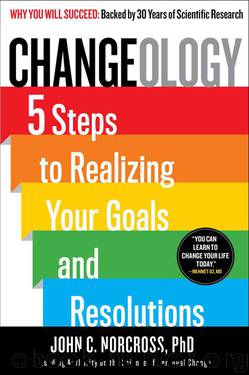Changeology: 5 Steps to Realizing Your Goals and Resolutions by John C. Norcross

Author:John C. Norcross [Norcross, John C.]
Language: eng
Format: epub, mobi
Publisher: Simon & Schuster
Published: 2012-12-24T23:00:00+00:00
CHECK YOURSELF: COUNTERING
Answer the following questions about your behavior in the past week using a 5-point scale: 1 = Never, 2 = Seldom, 3 = Occasionally, 4 = Often, 5 = Repeatedly.
I employed behaviors that are incompatible with or replace my problem.
______
I engaged in some physical activity or relaxation when tempted to give in to my problem.
______
I enjoyed doing my healthy alternative and find it to be a good substitute.
______
Success in Perspire is predicted and facilitated by regular use of countering, a minimum of 3 on the above items. If your score is lower than that, more countering is needed. If your score is there or higher, you are on track for moving on to the next step.
Congratulations! We’re halfway through the change catalysts of Perspire. See how quickly it goes when you’re having fun, learning new skills, and transforming your life? Now let’s move on to controlling your environment and enlisting more help from others on your journey. These two strategies are similar in that both require you to take charge of the people and things around you to foster change and avoid reverting to your old ways.
CONTROLLING YOUR ENVIRONMENT
We routinely underestimate the power of our environment to shape our behavior. That’s been the key lesson of social psychology in the past 50 years.
Based on now-famous experiments, we know that if we were to take healthy college students and tell some that they are to play the role of prisoners and others to play the guards in a mock prison setting, we’d witness an incredible, primal transformation. Within days, the prison environment and culture would lead students into their respective roles—either submissive or authoritarian—to the point that the experiment would have to be halted because of the level of brutality displayed by the “guards” toward the “prisoners.” If we were to ask a few research confederates to state that two plainly unequal lines look the same length, they would be able to get other people to agree with them. If we were to hold a fund-raiser for a good cause and introduce reluctant donors to avid volunteers, we’d watch peer pressure generate huge contributions. These three scenarios are not hypothetical; they were actual experiments that prove the power of our environment over us.
“Man is a child of his environment,” Shinichi Suzuki, the inventor of a method to teach violin to young pupils, wrote. But it turns out that that’s only half the truth: we shape the environment that shapes us.
In this section, I’ll help you select and create a climate in which positive change can flourish. You’ll learn, in other words, to harness the power of the environment; the child will become the parent.
Controlling one’s environment is, sadly, the least frequently used change catalyst in dozens of our studies, yet it can be tremendously beneficial. People can be so preoccupied with examining their inner thoughts and feelings that they neglect to keep their surroundings in sync with their goals. But you will not ignore the environmental strategy, at least not if you’re following the steps of Changeology.
Download
Changeology: 5 Steps to Realizing Your Goals and Resolutions by John C. Norcross.mobi
This site does not store any files on its server. We only index and link to content provided by other sites. Please contact the content providers to delete copyright contents if any and email us, we'll remove relevant links or contents immediately.
The Art of Thinking Clearly by Rolf Dobelli(10215)
Mindhunter: Inside the FBI's Elite Serial Crime Unit by John E. Douglas & Mark Olshaker(9196)
Change Your Questions, Change Your Life by Marilee Adams(7634)
Nudge - Improving Decisions about Health, Wealth, and Happiness by Thaler Sunstein(7615)
Mastermind: How to Think Like Sherlock Holmes by Maria Konnikova(7227)
The Power of Now: A Guide to Spiritual Enlightenment by Eckhart Tolle(5604)
Men In Love by Nancy Friday(5155)
Altered Sensations by David Pantalony(5044)
Factfulness: Ten Reasons We're Wrong About the World – and Why Things Are Better Than You Think by Hans Rosling(4693)
The Confidence Code by Katty Kay(4187)
Thinking in Bets by Annie Duke(4152)
Man and His Symbols by Carl Gustav Jung(4066)
The Worm at the Core by Sheldon Solomon(3433)
Why Buddhism is True by Robert Wright(3403)
Liar's Poker by Michael Lewis(3367)
Three Women by Lisa Taddeo(3353)
The Inner Life of Animals by Peter Wohlleben(3259)
Descartes' Error by Antonio Damasio(3229)
How Music Works by David Byrne(3186)
